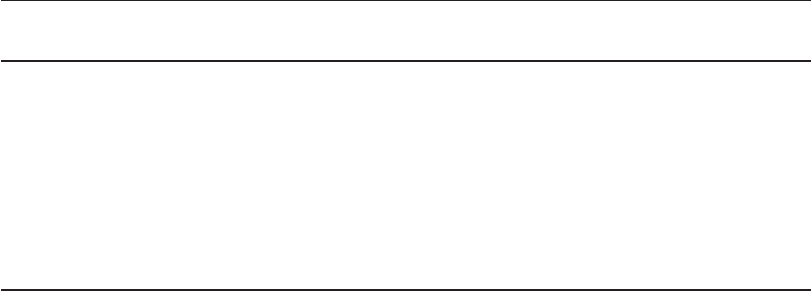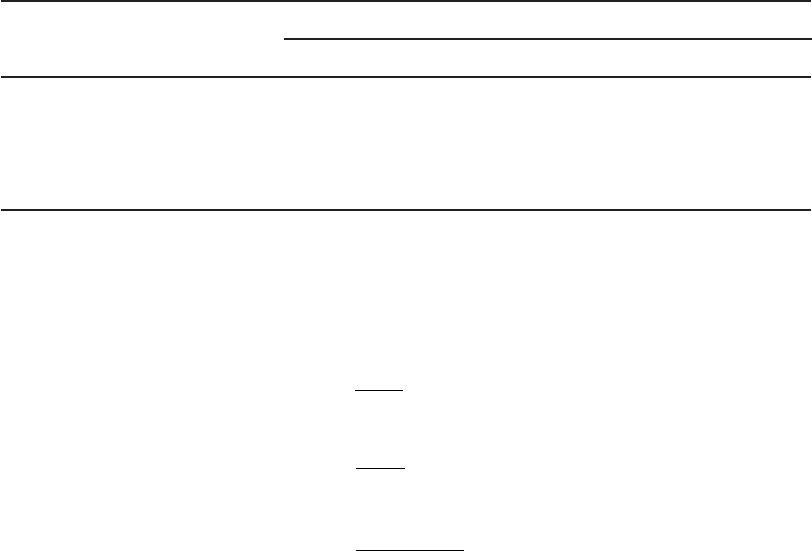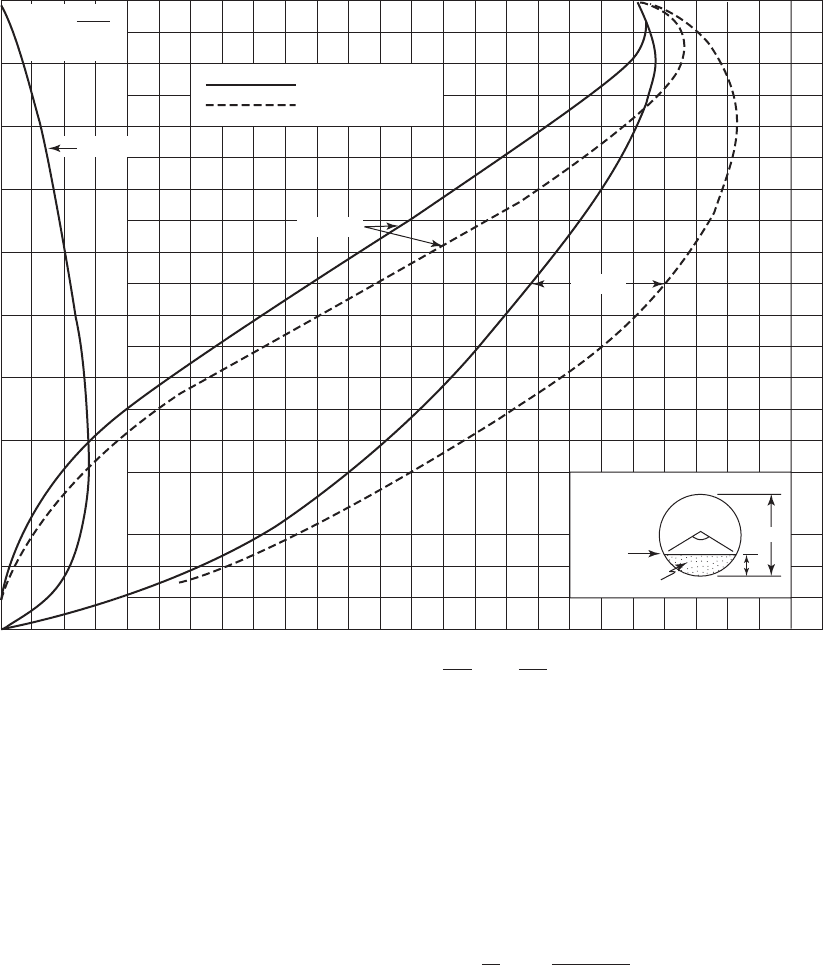Water and Wastewater Engineering
Подождите немного. Документ загружается.

19-10 WATER AND WASTEWATER ENGINEERING
Estimation of Wastewater Flow Rates
The required wastewater flow rates at the beginning of the service life and at the design life are
the average daily flow rate, peak hour flow rate, and the peak infiltration allowance. These were
discussed in detail in Chapter 18.
Pipe Material Selection
The principal sewer material for pipes with small or medium diameters is polyvinyl chloride
(PVC). For larger pipe diameters, ductile iron pipe (DIP), high density polyethylene (HDPE)
pipe, or reinforced concrete pipe (RCP) may be specified. Truss pipes are becoming more com-
mon for larger pipe diameters.
Vitrified Clay Pipe (
VCP). This classic pipe material has demonstrated its durability in use in
the United States for over a century. It has a high resistance to corrosion and abrasion. Its major
disadvantage is its high mass per unit length that makes it more difficult to handle and increases
installation costs. It is rarely installed today.
This pipe is made of clay or shale that has been ground, wet, molded, dried, and fired in a
kiln. Near the end of the burning process, sodium chloride is added to the kiln. It vaporizes to
form a hard waterproof glaze by reacting with the pipe surface. The firing of the cla
y produces a
vitrification of the clay that makes it very hard and dense (Steel and McGhee, 1979).
The pipe is manufactured with integral bell and spigot ends fitted with polymeric rings. It is
available in diameters from 75 mm through 1,050 mm and lengths up to 3 m (ASCE, 1982). Pipes
are typically joined
with push-on gasket joints.
Polyvinyl Chloride Pipe (PVC). This pipe is made by extrusion of polyvinyl chloride. It is
available in diameters from 10 mm through 1.2 m and lengths up to 6 m (ASCE, 1982). Rubber
gasket bell and spigot type joints are used to connect the pipes.
This pipe has been in use for over half a century. It i
s almost exclusively the material of
choice for pressure and vacuum sewers. Its advantages are corrosion resistance and low mass per
unit length. It is subject to attack by certain organic chemicals and excessive deflection if improp-
erly bedded. The low m
ass per unit length gives it some cost advantage in installation.
Ductile Iron Pipe (DIP). This pipe material was discussed in Chapter 17. Its primary applica-
tion for sewers is for force mains. Because wastewater is often corrosive, current practice is to
use a cement mortar lining and an asphaltic outer c oating. Epo
xy coating may be used in trunk
sewers. DIP manufacturers recommend that the pipe be encased in a loose-fitting flexible poly-
ethylene tube (0.2 mm thick) when the pipe is to be placed in corrosive soils.
High-Density Polyethylene (HDPE). This pipe material was discussed in Chapter 17. Its
primary us
e is as an alternative pressure pipe for force mains.
Reinforced Concrete Pipe (RCP). Precast RCP is manufactured by a variety of techniques
including centrifugation, vibration, packing, and tamping for consolidating the concrete in forms.
Adjustment of the wall thickness, concrete strength, and reinforcing allow for a wide variety of
strengths.

SANITARY SEWER DESIGN 19-11
The pipe is manufactured with integral bell and spigot ends. It is available in diameters from
300 mm through 5.0 m, and lengths up to 7.5 m (ASCE, 1982). These pipes are typically joined
with push-on gasket joints.
The normal service for RCP is for trunk lines and interceptor sewers. Its major limitations are
its high
mass per unit length and its susceptibility to crown corrosion.
Truss Pipe. This pipe is made of PVC or acrylonitrile butadiene styrene (ABS). It consists of
dual walls with a truss system between the walls. Sometimes the space between the walls is filled
with cement. It is more rigid than PVC pipe but shares the same ea
se of construction.
Crown Corrosion. The corrosion of the crown of a sewer is the result of biochemical reactions
in the sewage and in the condensed moisture at the crown of the sewer. With long sewer reaches
and little oxygen transfer from the air in the sewer, or when sewage sits for long periods between
pumping in force mains (e.g., in residential areas with little or no nighttim
e flow), the sewage
becomes anoxic or anaerobic. Under these c onditions, the sulfate in the sewage is reduced to
sulfide. At the usual pH level of domestic sewage, the s ulfide is converted to hydrogen sulfide.
In poorly ventilated sewers, moisture collects on the walls and the
crown. Hydrogen s ulfide
dissolves in this moisture. As such it does no harm.
Bacteria capable of oxidizing hydrogen sulfide, in particular those of the genus Thiobacillus,
are always present in sewage. At high flows, these bacteria are brought to the walls and crown
where they adhere after the high flows recede. They ox
idize the hydrogen sulfide to sulfuric acid
by the following reaction (Sawyer et al., 2003):
HS O HSO
bacteria
22 24
2
⎯→⎯⎯
←⎯⎯⎯
(19-1)
This strong acid-attacks acid soluble materials such as concrete, iron, or steel. The corroded
crown fails under the load of soil above it. These processes are summarized in Figure 19-8 .
O
2
O
2
O
2
O
2
O
2
O
2
H
2
S
H
2
S
H
2
S
H
2
S
H
2
SH
2
SH
2
S
H
2
S
O
2
Air
Wastewater
Anaerobic
conditions
S
2ⴚ
SO
2ⴚ
4
Home of H
2
S
oxidizing bacteria
Water droplets
H
2
S 2O
2
H
2
SO
4
bacteria
H
2
S
S
2ⴚ
ⴙ
2H
ⴙ
FIGURE 19-8
Formation of hydrogen sulfide in sewers and “crown” corro-
sion resulting from oxidation of hydrogen sulfide to sulfuric acid.
( Source: Sawyer et al., 2003.)
19-12 WATER AND WASTEWATER ENGINEERING
Where wastewater temperatures are high, detention times in the sewer are long, and the
sulfate concentrations in the sewage are high, this is a particularly serious problem that must be
considered in the selection of pipe materials. Because they are not s usceptible to crown corro-
sion, VCP and PVC pipe are frequently chosen for these applications. When very large
diameters
require the use of RCP pipe, it should be lined with corrosion resistant material.
Design Criteria
The design criteria discussed in this section apply to gravity flow sewers. Other criteria are used
for alternative sewer systems such as pressure and vacuum sewers.
Location. In the construction for new residential areas, the sewer is commonly placed on one
side of the roadway in the right-of-way (ROW). Connection
s to the sewer from buildings on
the opposite side of the street may be made by boring und er the street. In established communi-
ties (or where local codes require), it may be found in alley ways behind the residence or in the
street.
Sewers should be at such a depth that they c
an receive the contributed flow by gravity.
Where houses have basements, the invert of the sewer is placed a minimum of 3.0 to 3 .5 m
below grade. Where there is no basement, it is placed to provide sufficient cover to protect the
pipe from live load and dead load damage. Moser (2001) provides guidanc
e on design to prevent
live and dead load damage. Where building codes are in place, they should be consulted for the
appropriate depth. In the absence of other guidance, a rule of thumb is to use a sewer invert depth
of 1.8 to 2.4 m below grade when basements are not present.
B uilding codes may prohibit gravity
service from the basement. If sewage is to be removed
from the basement level, grinder pumps are installed.
When sewers cannot be placed at a depth sufficient to prevent freezing, for example, when
bedrock is near the surface, they must be insulated (GLUMRB, 2004). Countermarsh (1998) dis-
cusses alternative des
igns for these conditions.
Maximum sewer depth is approximately 8 to 9 m. When the depth exceeds 8 to 9 m, a lift sta-
tion is provided. In exceptional circumstances, the sewer may reach a practical construction limit
of 10 to 12 m depth before a lift station is constructed
.
GLUMRB (2004) specifies that gravity sewers shall be laid at least 3 m horizontally (edge
to edge) from any existing or proposed water mains. Sewers crossing water mains shall be laid
to provide a minimum vertical distance of 0.45 m between the outside of the water main and the
outside of the sewer. It i
s preferable that the water main be located above the sewer. At c ross-
ings, one full length of water pipe shall be located so both joints will be as far from the sewer as
possible. The sewer shall be designed and constructed equal to water pipe, and shall be pressure
tested at 1,035 kPa to assure water tightness.
Pipe Size. No public gravity sewer conveying raw wastewater s
hall be less than 200 mm in
diameter (GLUMRB, 2004). This size has been selected to minimize clogging when extraneous
material enters the sewer.
Some engineers design sewer pipes to flow half full at the design capacity to provide a fac-
tor of safety. This practice is favored when designing laterals or branches that have the potential
to be extended to acco
mmodate growth. It is not justified for mains, trunk lines, or interceptors
(Steel and McGhee, 1979).

SANITARY SEWER DESIGN 19-13
Slope. All sewers shall be designed and constructed to give mean velocities, when flowing full,
of not less than 0.6 m/s based on Manning’s formula using an “ n ” value of 0.013 (GLUMRB,
2004). Manning’s formula is discussed in the next section.
Slopes are commonly calculated using the depth of the invert of the pipe. Mini
mum slopes to
achieve 0.6 m/s are shown in Table 19-2 . Slopes greater than these may be desirable to maintain
self-cleansing velocities at all rates of flow, for construction, or to control sewer gases. A mean
velocity of 0.3 m/s is usually sufficient to prevent the deposition of the organic solids in waste-
water. To prevent depo
sition of mineral matter, a mean velocity of 0.75 m/s is required. Slopes
that result in mean velocities of 0.5 m/s have been used, but these require frequent cleaning (Met-
calf & Eddy, 1981).
Sewers 1.2 m and larger should be designed and constructed to give m ean velocities, when
flowing full, of not less
than 0.9 m/s based on Manning’s formula and an “ n ” value of 0.13.
Oversizing sewers to justify flatter slopes is prohibited. The use of larger pipes at flatter
slopes will reduce the velocity well below the self-cleaning velocity.
The erosive action of the material suspended in the wastewater depends on the nature of the
material and the velocity at which it is
carried along. The erosive action determines the maximum
safe velocity of the wastewater. In general, maximum mean velocities of 2.5 to 3.0 m/s at the
design depth of flow will not damage the sewer (Metcalf & Eddy, 1981).
Where velocities greater than 4.6 m/s are anticipated, special provision must be made to pro-
tect against
displacement by erosion and impact. Sewers on slopes greater than 20 percent must
be securely anchored.
The slope between manholes must be uniform.
Alignment. In general, sewers less than or equal to 600 mm in diameter m ust be laid with
straight alignment between manholes. Curvilinear alignment of sewers large than 600 mm may
be permitted if compression joints are specified. Slopes must be increased with curvilinear align-
ment to maintain a minimum velocity above 0.6 m/s. The recommended practice is to u se extra
manholes and straight alignment between manholes.
TABLE 19-2
Recommended minimum slopes for gravity flow sewers
a
Nominal diameter,
mm
Minimum slope, m/m
n 0.013
Minimum slope, m/m
n 0.010
Capacity, flowing full,
m
3
/s
200 0.0033 0.0020 0.019
250 0.0025 0.0015 0.029
300 0.0019 0.0011 0.042
350 0.0016 0.0009 0.058
375 0.0014
0.0008
b
0.066
400 0.0013
0.0008
b
0.075
450 0.0011
0.0007
b
0.095
500 0.0010
0.0006
b
0.118
600
0.0008
b
0.0005
b
0.170
a
Calculated using Manning’s equation with nominal pipe diameter and v 0.6 m/s.
b
The minimum practicable slope for construction is about 0.0008 m/m.

19-14 WATER AND WASTEWATER ENGINEERING
Changes in Pipe Size. When a smaller pipe joins a larger one, the invert of the larger sewer
should be lowered sufficiently to maintain the same energy gradient. An approximate method for
securing this result is to place the 0.8 depth point of both sewers at the same location.
In no instance should a larger pipe discharge into a smaller pipe. Even though a smaller pipe
at a steeper slope may be able to carry the larger flow, there i
s the potential for objects that will
travel freely in the larger pipe to obstruct the smaller pipe.
Manholes. Manholes are placed at the junction of two or more sewers , at changes in vertical
or horizontal alignment, at changes in sewer size, and at the end of each line. The spacing for
straight runs is shown in Table 19-3 .
Drop manholes are used when the inflow and outflow sewers differ in elevation by more then
0.6
m. They may also be used to reduce the slope when the veloc ities exceed erosive velocities
(2.5–3.0 m/s).
The manholes in small sewers are typically about 1.2 m in diameter. A minimum access
diameter of 0.6 m is provided. Although the same size m
anhole barrel is used for both small and
large manholes, the base will be larger for sewers larger than 600 mm.
Although the American Society of Civil Engineer’s manual on sewer design (ASCE, 1982)
suggests that it is unnecessary, current practice is to provide an arbitrary minimum drop of 30 mm
across the standard
manhole. Otherwise, the grade through the manhole should match the energy
grade line for larger diameters or with size change.
Hints from the Field. Experience has yielded the following useful rules of thumb. These are
not design criteria but rather practical considerations in applying the design criteria.
• In normal practice, the grou
nd slope is used as a first trial for selecting the slope. However,
there are a number of exceptions. For example:
a . If the ground is flat, select the minimum slope to achieve a velocity of 0.6 m/s with the
sewer flowing full.
b. If there is a slight upgrade for a short distance, select the minimum s
lope to achieve a
velocity of 0.6 m/s with the sewer flowing full.
c. If the ground slope yields a velocity greater than 2.5 m/s, then select a lower slope.
TABLE 19-3
Typical manhole spacing for straight runs
a
Pipe diameter Spacing
375 mm or less 120 m or less
450 to 750 mm 150 m
or
450 to 750 mm 180 m with adequate cleaning equipment
825 to 1,200 mm 180 m
1,200 mm or greater 460 m
a
The actual spacing is highly dependent on local conditions and client preference.

SANITARY SEWER DESIGN 19-15
• A drop manhole may be used to minimize excessive velocity in a steep sewer. Alternatively,
consider designing the sewer as a gravity force main or pressure pipe with energy dissipa-
tion at the downstream end of the pipe (Orsatti, 1996).
• Because lift stations are expensive to build, operate, and maintain, avoid them to the
maxi-
mum extent possible by considering alternative routing.
• Because drop manholes are expensive to bu ild and often become plugged or fail structur-
ally, avoid them to the m aximum extent possible by considering the alternative of extra
excavation.
• In the upper reaches of the c
ollection system (e.g., in residential subdivisions), there
will seldom be enough flow at average or, perhaps, even at maximum discharge rates to
achieve a minimum velocity of 0.6 m/s in a 200 mm diameter sewer at minimum slope.
This means that a regular maintenance program that includes c
leaning the sewer will be
required.
Summary. The design criteria for sewers are summarized in Table 19-4 .
Design Equations
Two equations serve in the design of sewers: the Hazen-Williams equation introduced in
Chapter 3 (Equation 3-2) and Manning’s equation. Of these two, the Manning equation has found
wide application in sewer design because it applies both to sewers flowing full and those flowing
partially full—the latter being the condition most frequently encountered. Three us
eful forms of
Manning’s equation are:
v
n
RS
1
2 3 12//
(19-2)
S
vn
D
()()( )
()
22
1 333
6 3448.
.
(19-3)
Q
n
RSA
1
2 3 12//
(19-4)
where v velocity, m/s
n coefficient of roughness, unitless
R hydraulic radius, m
cross-sectional area of flow m
wetted peri
,
2
mmeter m,
S slope of energy grade line, m/m
D diameter of pipe, m
Q flow rate, m
3
/ s
A cross-sectional area of flow, m
2
The selection of an appropriate value for n i s typically based on the pipe material and its con-
dition. There is a large body of work that has been devoted to the determination of n for various
surfaces. Selected values from the literature are shown in Table 19-5 on page 9-17.

19-16 WATER AND WASTEWATER ENGINEERING
A s noted above, GLUMRB (2004) specifies that n 0.013 for the calcu lation of minim u m
velocity. Designers typically use n 0.013 for PVC because, once the pipe is in use, this n i s
more realistic.
For a pipe flowing full, the hydraulic radius is defined as
R
D
D
D
()()
/4
4
2
(19-5)
TABLE 19-4
Typical design criteria for gravity sewers
Parameter Recommendation Comment
Pipe material PVC For main sewers
Pipe diameter 200 mm minimum Nominal diameter
Size to carry peak flow rate See Table 19-2
Slope To achieve 0.6 m/sFlowing full, Manning’s
n 0.013, see Table 19-2
Maximum velocity 2.5 to 3.0 m/s
Depth to invert 3.0 to 3.5 m minimum When basem
ents are present or
0.6 m below the lowest basement
1.8 to 2.4 m When no basements are present
8 to 9 m maximum
Depth to crown
H D/6 minimum
For dead load; granular soil
For live load see Moser (2001)
Location with respect to
water mains
3.0 m horizontally
0.45 m vertically
When crossing
Edge to e
dge
Outside to outside; water above
sewer
Full length to joint for water main
or encased sewer
Alignment Straight between manholes 600 mm or less
Manholes Place at:
junction of two sewers
change in vertical alignment
change in horizontal alignment
change in pipe size
at end of each line
Spacing for straight runs See Table 19-3
Effluent elev. Influent elev.
0.03 m
To acc
ount for entrance and exit
losses
Drop manholes When inflow and outflow inverts
differ by more than 0.6 m
Manhole diameter 1.2 m minimum Access 0.6 m

SANITARY SEWER DESIGN 19-17
where D diameter of pipe in meters. Similarly, for a pipe flowing half-full, R D /4. For
pipes flowing full or half-full, other useful forms of Manning’s equation are:
v
n
DS
0 397
2 3 12
.
()
//
(19-6)
Q
n
DS
0 312
8 3 12
.
()
//
(19-7)
S
nQ
D
10 3
22
16 3
.( )( )
()
/
(19-8)
For other fractional flows, the estimate of R i s quite complex. Camp (1946) developed
a graphical solution procedure. Camp’s graph (adapted in Figure 19-9 ) depicts the nonlinear
behavior of several variables in the Manning equation. To begin with the obvious, the curves
are based on the value of the variable when the pipe is flowing full. In common notation, a capi-
tal letter is used for the valu
e of the variable when the pipe is flowing full, that is, D, V, and Q.
A lower case letter is for the value of the variable when the pipe is flowing partially full, that
is, d, v, q.
Research on asbestos-cement, DIP, VCP, and RCP pipe has revealed that Manning’s n varies
with depth as shown on the left-hand side of Figure 19-9 (Bloodgood and Bell, 1961; Pomeroy,
1967). The functional form is as follows (ASCE, 1982):
nk D
mm
()( )//213 6
(19-9)
where n Manning’s n
k effective absolute roughness, or height of wall roughness, m
m proportionality factor
D diameter of pipe, m
The value of m is slightly less than 1/3 for turbulent flow.
TABLE 19-5
Typical values of n that are used with the Manning equation
Condition
Pipe material GoodFair Deteriorated
DIP (lined) 0.011
0.013
a
0.015
HDPE
0.010
a
0.011 0.013
PVC
0.010
a
0.011 0.013
RCP 0.013
0.015
a
0.018
VCP
0.013
a
0.015
a
0.017
a
Values commonly used in design.

19-18 WATER AND WASTEWATER ENGINEERING
In contrast to the pipes noted above, PVC pipe with flows from 0.2 D to full do not indicate a
significant variation in n with depth. Data for discharge and velocity approximate the curves that
are obtained using an assumption of a constant n (Neale and Price, 1964).
The shape of the velocity ratio curve is primarily a function of the change in the hydraulic
radi
us with depth of flow. From simple geometric relationships, for pipes flowing partially full,
this can be shown to be:
R
D
4
1
180
⎛
⎝
⎜
⎞
⎠
⎟
⎛
⎝
⎜
⎞
⎠
⎟
sin
(19-10)
where R hydraulic radius,m
D pipe diameter, m
angle subtended by the segment of the pipe diameter occupied by the wastewater
(see inset in Figure 19-9 ), degrees
0
0
0.1
0.2
0.3
0.4
0.5
0.6
0.7
0.8
0.9
1.0
0.1 0.2 0.3 0.4 0.5 0.6 0.7 0.8 0.9 1.0 1.1 1.2 1.3
Hydraulic elements
and
v
V full
q
Q full
Ratio of depth to diameter d/D
D
d
Sewage
level
Particulate matte in sewage
n variable with depth
n constant
n
Values of
n full
1.1 1.2
1.3
Mannings’ n
Discharge
Velocity
FIGURE 19-9
H ydraulic properties of circular sewers. (Adapted from Camp, 1946.)

SANITARY SEWER DESIGN 19-19
Note that cos 1/2 q 1 2 d / D. The shape of the discharge ratio curve is a function of the change
in both the area and hydraulic radius as a function of depth. The behavior of the area as a function
of depth is described by Equation 19-11:
A
D
2
4 360
2
sin
⎛
⎝
⎜
⎞
⎠
⎟
(19-11)
E xample 19-1 illustrates the use of Figure 19-9 in estimating the velocity of sewage flowing
in a partially full sewer.
Example 19-1. Determine the velocity of 0.0081 m
3
/ s flow in a 200 mm diam eter sewer at a
slope of 0.0040 m/m. The pipe is new VCP.
Solution.
a . Estimate the velocity and flow rate for the sewer flowing full. The hydraulic radius for
flowing full is D /4 and n 0.013 for new VCP ( Table 19-5 ). Using Equation 19-6:
v
full
//
mm/m
0 397
0013
0 200 0 0040
2 3 12
.
.
..()( )
==()( )( )30 53 0 3420 0 0632066.. . . m/s
Using Equation 19-7:
Q
full
//
mm/m
0 312
0 013
0 200 0 0040
83 12
.
.
..()( )
()()()24 00 0 0137 0 0632 0 0208
3
.. . .m /s
b. Calculate Q / Q
full
.
Q
Q
full
m /s
m /s
0 0081
0 0208
039
3
3
.
.
.
c. Enter Figure 19-9 on the abscissa at Q / Q
full
0.39 and draw a vertical line to the dis-
charge curve labeled “ n variable with depth.” From the intersection point, draw a hori-
zontal line to the velocity curve labeled “ n variable with depth.” From this intersection
point, draw a vertical line down to the abscissa and read v / v
full
0.78.
d. The velocity flowing partially full is then
vv 078 078 066 051....m/sm/s
full
()( )
Comments:
1 . The specification of new VCP pipe was used to select n 0.013 and to select the “ n
variable with depth” curves. For plastic pipe, the value for n i s 0.010, and the curves
selected would be “ n constant.”
2. The use of the graphs for estimating v / v
full
i mplies that calculated velocities should have
no more than two significant figures. In all likelihood, given the inherent errors in esti-
mating flow rates and Manning’s n, a s well as the use of the nominal pipe diameter, one
might argue that velocities should be limited to one significant figure.
